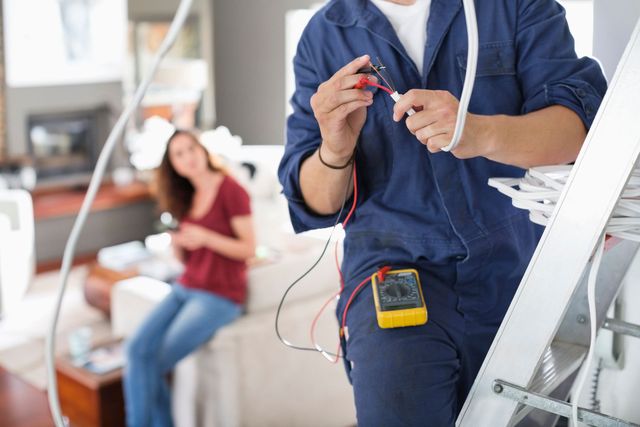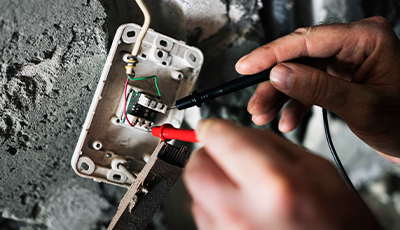Why wiring age is important, and how a Accredited Service Provider Level 2 Electrician can upgrade it
Usual Electric Problems Every Property Owner Need To Understand about
House owners often come across various electric issues that can affect safety and security and functionality. Concerns like flickering lights and tripped circuit breakers are extra usual than numerous realize. These scenarios can suggest much deeper electric concerns that warrant interest. Comprehending the signs and risks connected with out-of-date electrical wiring and dead electrical outlets is important. What procedures can be required to avoid these problems? Discovering these typical electrical concerns could disclose vital insights for preserving a risk-free home environment.

Flickering Lights: Causes and Solutions
Why do some home owners experience flickering lights? Flickering lights can be a typical annoyance, usually suggesting underlying electrical concerns. One main cause is loose or defective connections within lights or circuitry, which can bring about intermittent power supply. Furthermore, utilizing high-wattage devices on the very same circuit may cause voltage changes, causing lowering or flickering. Another possible issue is an overloaded circuit, where as well several gadgets attract power all at once, straining the electric system. In addition, degraded or outdated electrical wiring can add to irregular electrical flow. In some instances, flickering lights may indicate an issue with the home's electrical panel or service line. Home owners must resolve flickering lights promptly to stay clear of possible risks. Solutions might include tightening links, rearranging home appliance tons, or getting in touch with a certified electrician for a comprehensive assessment. Determining the root reason can help assure a safe and secure electric system in the home.
Tripped Circuit Breakers: What You Required to Know
Have house owners ever wondered what triggers their breaker to journey all of a sudden? This typical problem often arises from an overload of electric circuits, where a lot of devices draw power all at once. In such cases, the breaker serves as a safety device, interrupting the flow of electricity to avoid overheating and prospective threats. One more frequent cause is a brief circuit, which happens when a real-time cable get in touches with a neutral cable, creating a surge of power that trips the breaker. Ground mistakes can also result in tripped breakers; these occur when a real-time wire touches the ground or a grounded surface, posturing serious safety dangers. Home owners ought to on a regular basis analyze their usage of high-wattage devices to prevent overwhelming circuits. In addition, comprehending the function of breaker can assist them react suitably throughout a journey, ensuring their home stays properly maintained and risk-free.
Out-of-date Circuitry: Dangers and indications
Out-of-date wiring can posture considerable risks to property owners, frequently going undetected up until issues emerge. Residences developed before the 1980s might still have light weight aluminum wiring or knob-and-tube systems, which are no more taken into consideration secure. Signs of out-of-date electrical wiring include flickering lights, frequently stumbled circuit breakers, or shedding smells near outlets. These indicators may suggest that the electric system is overloaded or deteriorating.Additionally, homeowners may discover swelter marks around switches or electrical outlets, which can suggest getting too hot. The risk of electric fires significantly increases with outdated electrical wiring, as these systems were not developed to manage modern electric tons. Home owners are encouraged to have their wiring checked regularly, specifically when renovating or including brand-new home appliances. By recognizing these indicators early, they can prevent dangerous scenarios and preserve a more secure living atmosphere. Updating to current electrical standards is a positive action in maintaining home security and effectiveness.
Frequently Blown Fuses: Troubleshooting Tips
Frequent blown merges can show underlying electrical issues that may come from outdated electrical wiring or overloaded circuits. Home owners experiencing this problem must initially identify the appliances attached to the influenced circuit. It is advisable to prevent using numerous high-wattage gadgets at the same time, as this can bring about circuit overload. If the problem lingers, inspecting the fuse box for signs of wear or damage is critical; a defective fuse box might require replacement.Additionally, looking for loose links within the circuit can aid avoid future occurrences. Home owners should likewise confirm that the merges being utilized are of the proper amperage, as utilizing a wrong fuse see here can intensify the trouble. Consulting a licensed electrical contractor is advised to assess the electrical system better if these repairing tips do not settle the concern. Addressing these concerns quickly can aid mitigate dangers and ensure the safety of the home's electric framework.
Dead Outlets: Usual Causes and Solutions
When a house owner encounters a dead electrical outlet, it can often provide stress and confusion. Numerous common reasons might cause this problem. One constant perpetrator is a tripped circuit breaker, which can be easily reset. Homeowners must examine their electrical panel to check if any kind of breakers are in the off setting. Another possibility is a defective electrical outlet itself, which might need substitute. Additionally, loose electrical wiring connections within the outlet can interfere with power flow, making inspection essential.Sometimes, the issue may stem from an overloaded circuit, especially when numerous tools are connected. In such instances, rearranging the electrical load can deal with the issue. Home owners must also consider the age of their circuitry; older systems may require updates to meet modern-day electrical needs. If these actions do not fix the situation, consulting a qualified electrician is try these out advisable to ensure safety and security and proper medical diagnosis.
Electrical Shocks: When to Be Worried
Exactly how can house owners establish whether an electrical shock warrants worry? House owners should first analyze the severity and context of the shock. A light static shock, typically felt when touching metal objects, is normally safe and usual. Nonetheless, if the shock occurs while interacting with a plugged-in home appliance or outlet, it may indicate a much more serious issue.The place and regularity of the shocks are vital. Repeated shocks from the very same resource, specifically in wet areas like restrooms or kitchens, could signify damaged wiring or poor grounding. Home owners should also consider the feeling of the shock; a shock that triggers pain or muscle mass contractions is more alarming than a plain tingle.If there's any uncertainty, it is advisable to consult a certified electrical contractor. Neglecting prospective electric threats can result in severe security risks, consisting of fire or serious injury.
Overloaded Circuits: Avoidance and Safety And Security Steps
Overloaded circuits pose substantial threats in residential settings, commonly causing electrical fires or devices damage (ASP Level 2 Electrician). Property owners have to acknowledge the signs of an overloaded circuit, such as regularly tripped breakers or lowering lights. Implementing precautionary safety and security methods can help minimize these risks and guarantee a more secure living atmosphere
Identifying Overloaded Circuits
What indicators suggest that a circuit may be overwhelmed? Homeowners need to be alert for numerous key indicators. Regularly tripped circuit breakers or blown integrates suggest excessive tons on the circuit. Dimming or flickering lights, specifically when other devices are in usage, can represent a poor power supply. Additionally, electrical outlets or buttons that feel cozy to the touch might indicate overheating, a prospective fire risk. Unusual humming audios from electrical outlets also necessitate attention, as they can signify electrical issues. If devices operate inefficiently or stop working to begin, it may be an indication of an overloaded circuit. Acknowledging these indications early can assist stop serious electrical issues and promote a more secure home atmosphere.
Preventive Security Practices
To maintain a effective and risk-free electrical system, homeowners need to carry out precautionary safety and security techniques that address prospective circuit overloads. One efficient action is to stay clear of connecting too numerous gadgets to a navigate to this website single electrical outlet, as this can exceed the circuit's capacity. Utilizing power strips with integrated breaker can help distribute power safely. Home owners must likewise consistently check cables and home appliances for damages and change any kind of damaged equipment immediately. It is vital to ensure that circuit breakers are operating correctly and to be mindful of the complete power level being used in each circuit. In addition, consulting a qualified electrical expert for periodic assessments can recognize potential issues prior to they escalate, assuring a more secure living setting and extending the life-span of electrical systems.
Regularly Asked Concerns
Exactly how Often Should I Have My Electric System Inspected?
Regular evaluations of electric systems are advised every three to five years. House owners should think about a lot more regular checks if they experience issues, undertake restorations, or reside in older residential properties to guarantee safety and conformity.
Can I Repair Electrical Problems Myself or Employ a Professional?

What Are the Indicators of an Electrical Fire Danger?
Indications of an electrical fire danger consist of regularly tripped breaker, flickering lights, shedding smells, blemished outlets, or warm, buzzing cables. Homeowners need to stay watchful and look for specialist assistance if any of these indications exist.
Exactly how Do I Know if My Home Requirements an Electric Upgrade?
To determine if a home needs an electric upgrade, indications consist of frequent circuit breaker journeys, outdated circuitry, inadequate electrical outlets, flickering lights, and the presence of older electric panels, suggesting prospective safety and security hazards and inefficiency.
Are There Particular Safety And Security Tips for Do It Yourself Electric Work?
When taking into consideration do it yourself electric work, one should always shut off power, make use of protected tools, verify circuit performance, comply with neighborhood codes, and speak with experts for complex jobs to assure security and avoid mishaps. One more potential concern is an overloaded circuit, where as well many devices attract power simultaneously, stressing the electric system. The danger of electrical fires markedly increases with obsolete circuitry, as these systems were not designed to take care of modern-day electrical lots. Regular blown fuses can suggest underlying electric issues that might stem from obsolete electrical wiring or overloaded circuits. To keep a risk-free and reliable electric system, property owners have to carry out precautionary safety techniques that deal with potential circuit overloads. Sydney Level 2 Electrician. Signs of an electric fire threat include often tripped circuit breakers, flickering lights, burning smells, discolored electrical outlets, or cozy, buzzing cords